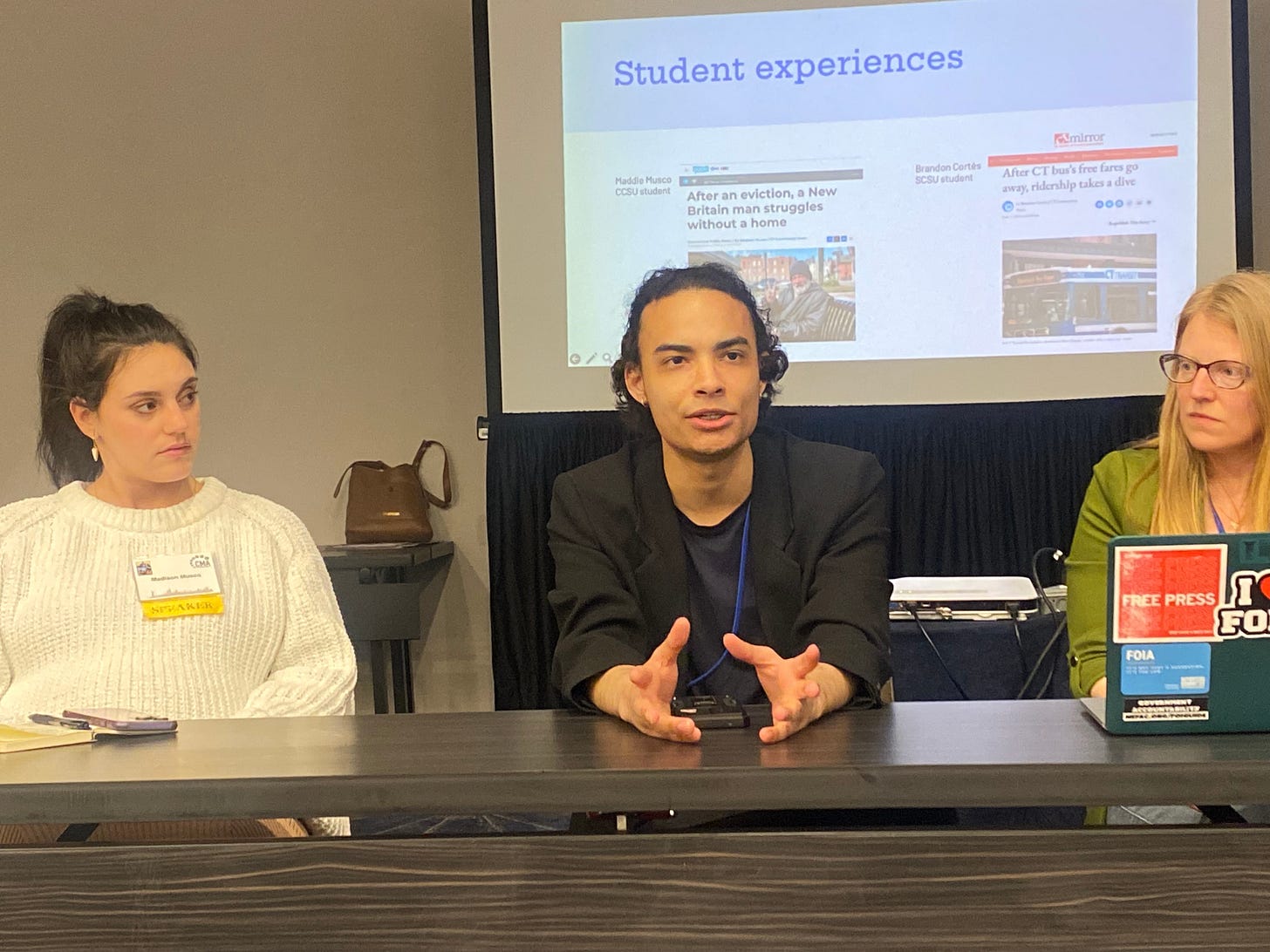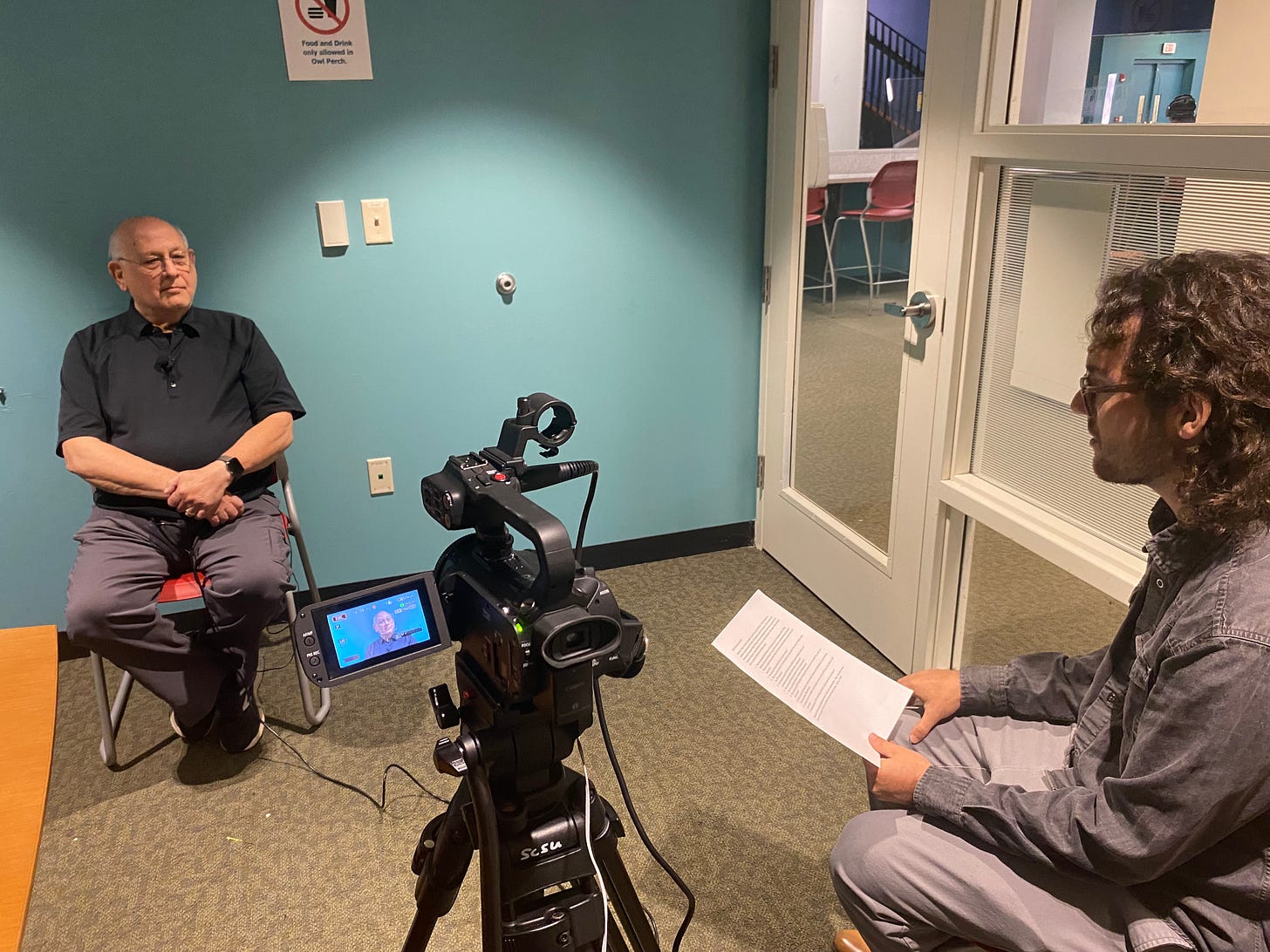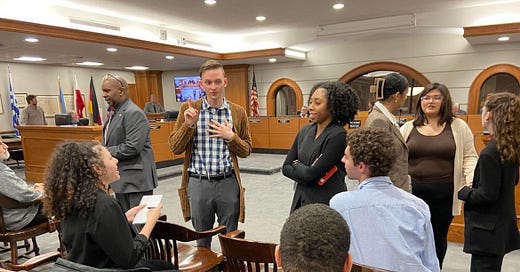State-funded journalism fellowships pitched in Connecticut
With statewide Student Journalism Collaborative already in place, its editor calls this the 'logical next step'

At the Connecticut Mirror, a public policy-focused newsroom, the most-read article during the week of Feb. 16 was written by a fellow.
“Our experience is that fellows and interns produce meaningful, high-quality work we would not otherwise have been able to publish,” said Bruce Putterman, the online outlet’s publisher and CEO.
Now, Connecticut is considering a proposal to create a journalism fellowship program that would place at least 12 recent journalism graduates from public institutions in local newsrooms.
The proposal comes as the state already boasts a statewide student journalism collaborative, and the network’s manager says this bill would be the “logical next step” to strengthen local journalism and provide aspiring reporters with real-world experience.
“There are fewer and fewer internships,” said Harriet Jones, editor and manager of the Connecticut Student Journalism Collaborative. “It’s hard for newsrooms that are being consolidated, that are getting smaller, to offer that kind of support to somebody who’s in their first job.”
The bill, currently in committee, would require the Office of Higher Education to fund the fellowships. It doesn’t yet have a price tag.
Democratic state Rep. Kate Farrar, who introduced the bill, said the state saw a 65% decline in local reporters in the past decade, in part due to the unsustainable business model.
“It’s really meant that the news organizations can’t hire new people,” Farrar said, explaining the goal of the bill is to build the capacity so these outlets “can cover more stories that are important to us locally and at the state level.”
Connecticut lost 56 newspapers between 2004 and 2023, according to Northwestern University Medill School of Journalism’s State of Local News report. Between 2023 and 2024, another three folded.
State Sen. Derek Slap said public officials might not always like what journalists have to say but generally agree that they are needed. He cited a bill passed recently to prevent improper spending by higher education officials after an investigation by CT Insider.
“I don’t know if we would have been passing that bill or if we would have had the spending under the microscope in the same way that we did … if it wasn’t for a reporter and great pieces of journalism, which we all learned from,” Slap said.’
Illinois passed a similar bill last year, establishing a Journalism Student Scholarship Program for journalism students who commit to working in a local newsroom for at least two years.
Putterman said fellowships could boost news production while training the next generation of journalists.
“Hyperlocal news sites throughout Connecticut depend on the passion and work ethic of a single person burning the midnight oil for little to no pay to make ends meet,” he said.
The Mirror, funded largely by philanthropy, hires 12 fellows or interns annually for 10 to 12 weeks, including students from the University of Connecticut, Columbia Journalism School and the Dow Jones Fund.

One-year-old statewide collaborative
If any group could potentially serve as a pipeline for the fellowship program, it’s the Connecticut Student Journalism Collaborative.
Sponsored by journalism faculty from public and private institutions, the year-old partnership recently secured tax-exempt status and publishes on CT Community News, highlighting “under-reported stories and issues that matter to Nutmeggers.”
Last spring, its pilot phase focused on minimum wage and economic issues reported by students from UConn, Southern Connecticut State University, and Central Connecticut State University.
Since then, the collaboration has expanded to include students from the state’s community colleges, the University of New Haven, Eastern Connecticut State University, and Quinnipiac University — a broader network than typical one-campus-based initiatives.
The collaborative doesn’t operate as a traditional newsroom, Jones said.
Faculty members identify and mentor students each semester, and students sign an expectation form. Professors edit stories before sending them to Jones for a final review.
Stories are then passed on to professional newsrooms for republication. Collaborative stories have appeared in the Mirror, CTNewsJunkie, Connecticut Public, WSHU Public Radio and The Hartford Courant.
“What we’re trying to do is to give professional opportunities to students who aren’t necessarily the students who have the financial backing or the connections to be able to go out and do a paid internship,” Jones said.
SCSU journalism professor Jodie Gil echoed that sentiment, saying it’s often easier for students to get published through classwork than to commute for unpaid, for-credit internships that may bring extra costs.
Gil’s first cohort included three students from her data reporting class, an independent study course. Their semester-long enterprise project was published through the collaborative.
“We saw it as an equity issue where we wanted to make sure that all students get these experiences, not just the ones who are able to do an internship that’s unpaid,” Gil said.
Although student journalists aren’t paid now, Jones said the 501(c)(3) status was meant to facilitate future fundraising.

Most students are local
As the program started at public institutions, many participants were homegrown.
“They’re from the communities that they’re reporting on, so they know what stories need to be told in those communities, they have good connections,” Jones said.
Of the eight CCSU students published last year, all were from Connecticut, said Kate Farrish, a former assistant journalism professor at the university.
While New Britain, where CCSU is located, isn’t exactly a news desert, Farrish said student reporters have the opportunity to tap into overlooked stories, such as youth mental health and loneliness among college students.
“We hear a lot about the effects of COVID on K-12 students, but the high school seniors who lost their prom and their graduation,” said Farrish, who’s now at UConn, “we suspect some of them are feeling lonely and isolated … that’s something we could look at.”
Jones said this collaboration, in a way, would diversify the pipeline of students entering the profession and make newsrooms aware that they can employ people from Connecticut who actually live in the communities they’re covering.
For instance, when the collaborative focused on homelessness, a CCSU journalist profiled a man who was living on the street, spending a few months sitting with him and getting to know him. The story later ran on Connecticut Public.
“That’s the kind of project that a student can do over a semester but it’s very hard for a local newsroom to spare somebody to do that kind of in-depth reporting,” she said. “I think our newsrooms have really appreciated the fact that we’re offering stories that they wouldn’t have the resources to do.”
Having bylines in professional outlets also motivates students. Farrish recalled bringing a physical copy of The Courant to class when her six students’ election stories were published.
“I held it up in class and said, ‘Look, look, guys, you're here in the Connecticut cover, in the Sunday Courant,’” she said. “And they all cheered for themselves. It was kind of a sweet moment.”
The ‘logical next step’
With fewer journalism jobs available, Jones said many graduates turn to freelancing, which, while viable, is difficult to sustain.
A structured fellowship program would help both students and newsrooms determine whether a fellow is a good fit for a full-time position, she said.
While she’s involved with the bill only as an individual supporter, Jones hopes the collaborative could serve in an advisory capacity in some way, if the bill passes.
“In terms of building that news ecosystem, we see ourselves very much as trying to build relationships between departments and newsrooms,” she said. “All of that relationship building can do nothing but good for news in Connecticut.”
Note: The Nutgraf is taking a publication break for a week. The next issue will run Monday, April 7.
💬 I want to hear from you! Would a program like this have influenced your decision to pursue journalism? Email me at nutgrafnews@gmail.com.
Story Spotlight:
👀 At least one student news outlet at the University of Florida avoided covering a campus event discussing the impacts of the state DEI ban for fear of losing funding, according to a federal lawsuit filed by the ACLU in January.
👮 Here’s how the UC Berkeley reporters exposed the system California police used to hide officer misconduct. After the story ran, several officers were fired, a probe was launched, and hundreds of readers demanded that state lawmakers prohibit clean-record agreements.
📝 Kentucky’s public universities routinely violate open records law — around 65% of the time, a Herald-Leader analysis has found.
Meanwhile, student journalists in Kentucky are pushing for new protections for the student press in the New Voices bill, WHAS 11 reported.
Featured Opportunities:
Join the Student Press Law Center March 24 for a panel on reporting on university DEI changes.
KUER 90.1, Utah’s largest NPR affiliate, is seeking a summer news intern. Apply before March 31.
GZERO Media is hiring two internship positions for reporting and video production.
MPR News is looking for a full-time reverb reporting intern for the summer. The application will close once finalists are selected.
WHYY in Philadelphia has multiple internship openings.
Join “The Future Press” team at the University of Texas for a webinar on testing AI in journalism April 2.
The Onion is seeking writers and creators to join its writing fellowship this summer. Deadline’s April 11.
Sign up for this “Get Help Covering Higher Ed Under Pressure” project by Open Campus, which provides journalists and newsrooms regular briefings on key developments, data tools, story ideas, a source database, consultation with higher-ed reporting specialists and connection with other journalists covering these issues for free.







